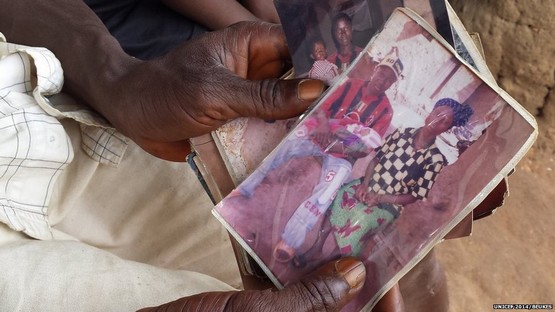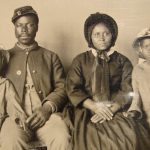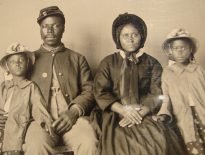Emile Ouamouno was just two years old and living in the remote Guinean village of Meliandou when he began suffering from a fever, headache and bloody diarrhoea.

In December 2013, despite his family’s best efforts, the young boy died – followed within days by his three-year-old sister Philomene and their pregnant mother Sia.
This was the start of an Ebola outbreak so devastating that it would kill more than 5,000 people in a year, leave hundreds of children orphaned and affect thousands more.
The village of Meliandou sits deep within the Guinean forest region, surrounded by towering reeds and oil palm cultivations – these are believed to have attracted the fruit bats carrying the virus passed onto Emile.
In a pattern that has come to characterise the spread of this deadly virus as it tears into close-knit communities, Ebola infected village health workers before spreading to nearby districts.
But the first few deaths failed to set off any alarm bells. Meliandou, located in Guinea’s Gueckedou province, is isolated. It is two hours to the nearest city on a difficult road and people are accustomed to endemic diseases with early symptoms mimicking those of Ebola.
Add to that a porous land border, with many people regularly crossing into Liberia and Sierra Leone in search of markets to sell their products, and the deadly virus was able to smoulder undetected across unsuspecting communities for three months.
Early on, hospitals quickly became Ebola incubators as health workers and doctors who believed they were dealing with cholera or Lassa fever, a much less deadly haemorrhagic virus prevalent in the region, fell ill after treating patients.
Of the first 15 deaths documented in the New England Medical Journal’s analysis tracing the current Ebola outbreak, four were health staff.
As grieving relatives gathered to bury their loved ones, one funeral turned into many.
Across the region, the ritual preparation of bodies for burial involves washing, touching and kissing, with funerals often attracting large numbers of mourners from nearby districts.
These rituals simply helped the disease to spread.
US doctor William Fischer, who worked in Guinea over the summer, said that by “transforming tradition into transmission, Ebola managed to spread by attacking the fabric of West African society.
How the outbreak started

Liberia: On the brink of collapse
Lack of resources have stymied the battle to combat Ebola in Liberia, leaving the countryteetering on the brink of collapse.
The first case across the border was confirmed a few days after the World Health Organization (WHO) officially declared the outbreak on 23 March.
But it was not until August that the virus really took hold in the capital Monrovia, a densely packed and notoriously poor city in the Montserrado district.
Throughout September, the county was reporting more than 200 new cases each week.
Monrovia is home to around a quarter of Liberia’s total population. The majority of its residents are crammed into rubbish-strewn slums, many of which are built on low-lying swamps and are unconnected to a municipal sewage system.
Ravaged by a 14-year violent civil conflict, that ended in 2003 and saw the near-total destruction of its infrastructure, Liberia’s health services struggled to deliver basic services long before the Ebola outbreak.
With only around 60 Liberian doctors before the Ebola outbreak, the death of a number of its high profile and most competent medical professionals left the country’s health staff decimated and demoralised.

Although the infection rate has declined since the summer, the country remains in a precarious position.
Fear of Ebola still prevails and many of those infected continue to stay home.
“People are hesitant and fearful as they don’t know what happens in a treatment unit and have heard lots of negative stories,” says Darin Portnoy, a medical doctor treating patients at a Medicines Sans Frontieres unit in Monrovia.
“That’s where we lose the battle – when people hesitate to come in. We can’t get on top of the disease when people turn up four, five days into their illness.”
Liberia’s health ministry has also urged people to stop burying their loved ones secretly at night.
Even as knowledge of best practices to protect from the virus infiltrates the entire region, this will perhaps be the hardest thing to stamp out.
To die of Ebola is one thing, but to be deprived of an afterlife is quite another, writes Prof James Fairhead, an anthropologist based at Sussex University and an expert on West Africa.
Ebola deaths in West Africa
Up to 23 November
5,689
Deaths – probable, confirmed and suspected
(Includes one death in US and six in Mali)
- 3,016 Liberia
- 1,398 Sierra Leone
- 1,260 Guinea
- 8 Nigeria
Sierra Leone: One funeral – 365 deaths
It was one unsafe burial that ended up leading directly to Sierra Leone’s explosion of Ebola cases in the summer.
The country’s first diagnosed case, when a pregnant woman was admitted to a hospital in the Kenema district following a miscarriage on 24 May, infected no-one else.
Identifying the source of her infection, however, illustrates how the virus entered the country.
The woman had attended the recent funeral of a well-known traditional healer. The healer had treated Ebola patients flocking to seek her care across the border from Guinea’s Gueckedou region, before dying herself.
Health teams working in the region identified a further 13 women who caught the virus attending the same burial, starting a chain reaction of infections, deaths and more funerals.
According to the WHO, “quick investigations by local health authorities suggested that participation in that funeral could be linked to as many as 365 Ebola deaths”.
From there Ebola spread to Sierra Leone’s capital Freetown where overcrowded living conditions and fluid population movements helped it to spiral further out of control.
A tragic footnote at the end of the study produced by doctors and scientists tracing the outbreak into Sierra Leone highlights the ultimate price some health workers have paid.
Five of the report’s co-authors, including Sierra Leone’s leading physician spearheading the fight against haemorrhagic illnesses in West Africa, contracted Ebola and died before the report was published.

Nigeria: A success story
The tale of another act of true human sacrifice explains how Nigeria has managed to beat Ebola and pull off what the WHO has called a “spectacular success story”.
A country home to 170 million, Nigeria has almost seven times the combined population of Guinea, Liberia and Sierra Leone.
A rapid response and effective tracing of almost 1,000 individuals who may have been exposed to the virus meant the number of Ebola deaths in Nigeria was limited to eight.
At the heart of the fight against Ebola in Nigeria was Dr Ameyo Stella Adadevoh.
Dr Adadevoh diagnosed American-Liberian Patrick Sawyer with Ebola when he was hospitalised in Lagos.
The doctor and her staff physically intervened when Mr Sawyer tried to leave the treatment centre. This action cost Dr Adadevoh and three medical staff their lives when they too contracted the disease.
A new phase
Almost a year from two-year-old Emile’s death, at least 5,500 people are estimated to have died from Ebola.
Many more deaths have gone unrecorded.
Efforts to tackle Ebola have been hindered by fierce resistance from local communities with a history of suspicion towards any outside intervention.
This has enabled new chains of transmission to pop up and threaten to spiral out of control.





